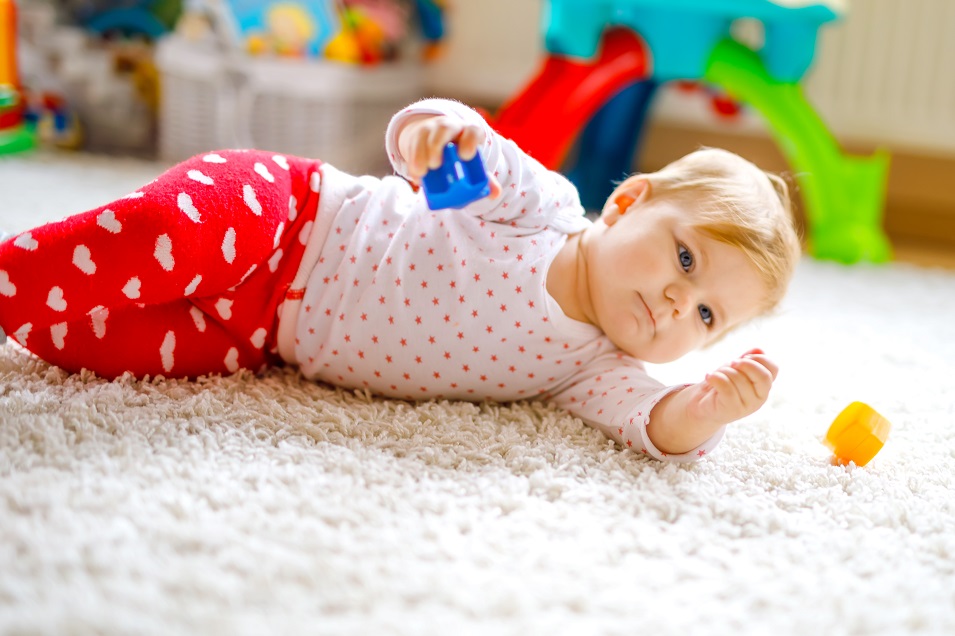Why Sidelying Play is Great for Your Baby’s Development
Most moms hear the message “Back to Sleep” loud and clear. As a result, some become overly afraid of placing their baby in any other position. While the Back to Sleep® campaign has decreased crib deaths, it has created other problems, such as more cases of plagiocephaly (flat spots on baby’s head) than seen in earlier generations. Read 10 Ways to Avoid the Baby Helmet for more information.
In addition to sleeping on their backs, many babies spend too much time on their backs during waking hours also. For example, many of today’s infants practically live in car seats or sleep in carriers as we run errands or work from home. Yes, your baby should sleep on its back for safety reasons, but awake time should incorporate other positions, including sidelying.
What about Tummy Time?
Tummy time play is essential and should be done frequently when your child is awake. For those babies who spit up often or are intolerant of the tummy position, get my 10 Steps for Happy Tummy Time resource so you and your baby can enjoy this critical play position.
What’s So Great About the Sidelying Position?
Many mothers alternate between placing their infants on their backs or on their tummies. But there’s another important play position that most moms miss entirely—it’s sidelying. Many positive developmental things occur when you place your child onto their side to play. Share on X
Background on Motor Development
In the early months of your baby’s life, all motions are influenced by reflexes. Reflexes are prewired motor patterns designed to assist survival. Your baby’s head and body position activates many of those reflexes. For example, when your baby is on its back, it’s harder for your child to clasp hands across the chest because of the effect of some reflexes and gravity. But when your child is on its tummy, it’s easier. Gravity and those reflexes affect all motions your baby makes.
The sidelying position minimizes the effects of gravity and decreases the impact those early reflexes have on your baby’s motions. For example, when your infant lies on the side, it’s much easier for them to clasp hands or get both hands to their mouth. This sidelying position becomes even more powerful in helping your baby’s motor development as they move past three months old when rolling and crawling become goals.
How Do I Do Sidelying Play?
If you’d like to incorporate sidelying play into your baby’s waking hours, here’s how:
- Lay your baby on its side in the crib, on the playmat on the floor, or even on your chest as you recline.
- Place something, maybe your arm or leg, against their back to prevent them from rolling backward.
- Place a favorite toy in front of them so they can try to touch or grab it. Easy-to-grasp rubber teething rings or rattles that make gentle sounds are ideal.
- Do this position for a few minutes each session. And remember to change sides—some playtime on the left and a little on the right.
Or watch my YouTube® video on how to do it.
In conclusion, continue placing your baby on its back to sleep and do regular tummy time. But, include some sidelying play in your baby’s day. For example, those early mobility goals of rolling and crawling are easier to achieve when your baby plays on its side.
Is your baby’s development on track? Grab my Milestone Chart for Moms and track like a pro. My free resource contains motor, social, communication, cognitive, and adaptive milestones.
Does your baby ever play on its side?
(Photo: Adobe Stock)
Disclaimer: All information presented is general education and is not intended as specific prescriptions for your child. If you have concerns about any aspect of your baby’s development, talk with your doctor. If your child is receiving any intervention or therapy, this information is not intended to be used without their knowledge.

 Only God and His ways will satisfy you and th
Only God and His ways will satisfy you and th

